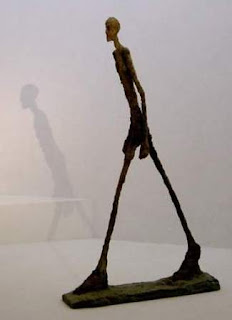
Waiting for Godot?

Henri Matisse, Harmony in Red, 1908. Oil on canvas, 80 x 220 cm. Hermitage Museum, St Petersburg
"What I dream of is an art of balance, of purity and serenity devoid of troubling or depressing subject matter — a soothing, calming influence on the mind, rather like a good armchair which provides relaxation from physical fatigue." Matisse
ANYTHING GOES
In olden days a glimpse of stocking,
Was thought of as something shocking.
But now, God knows,
Anything goes.
Cole Porter
In olden days a glimpse of stocking,
Was thought of as something shocking.
But now, God knows,
Anything goes.
Cole Porter

Marcel Duchamp, The Fountain, 1917. Readymade (urinal). Present whereabouts unknown

Pablo Picasso, The Charnel House, 1944-45. Oil and charcoal on canvas, 199.8 x 250.1 cm. Museum of Modern Art, New York
"What do you think an artist is? An imbecile who only has eyes if he's a painter, ears if he's a musician, or a lyre in every chamber of his heart if he's a poet — or even, if he's a boxer, only some muscles? Quite the contrary, he is at the same time a political being constantly alert to the horrifying, passionate or pleasing events in the world, shaping himself completely in their image. How is it possible to be uninterested in other men and by virtue of what cold nonchalance can you detach yourself from the life that they supply so copiously? No, painting is not made to decorate apartments. It's an offensive and defensive weapon against the enemy." Picasso
POST WAR ART IN EUROPE. World War II presented Europe with a major disaster and artists raged at the hypocrisy of society—it's willingness to destroy life in spite of pretensions to humanism and justice. The existentialist writer, Sartre expressed the core philosophy of post-war art movements in Europe: "Man is alone in the world in a metaphysical void... the individual is free to seek his own way." Angst over the brutality of war produced "an anti-aesthetic primitivism" (rather than the cool and absurdist expressions of Dadaists). The approach encouraged the concept of man's inner life as a valid subject, producing an intuitive style. The paintings of Dubuffet feature flat, grotesque figures which express his low regard for conventional standards of beauty and composition (Wheeler).

Francis Bacon, Three Studies for Figures at the Base of a Crucifixion (right-hand panel detail), 1944-45. Tate Gallery, London
"Man now realizes that he is an accident, that he is a completely futile being, that he has to play out the game without reason. […] Painting has now become, or all art has now become, completely a game by which man distracts himself." Bacon

Co Westerik, Schoolmaster and Child (Schoolmeester met kind), Holland, 1961. Oil and tempera on canvas, 88,5 x 110 cm. Gemeentemuseum Den Haag

Quino (Joaquin Salvador Lavado), Untitled, ink on paper.
Danchev about Picasso







No comments:
Post a Comment